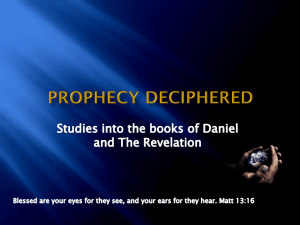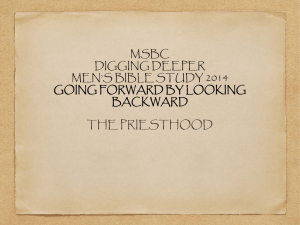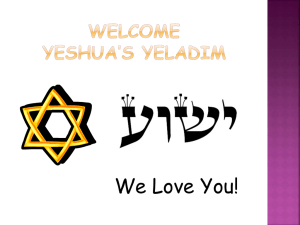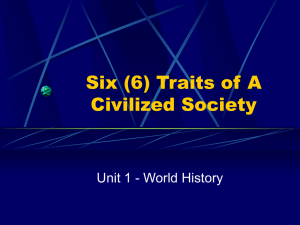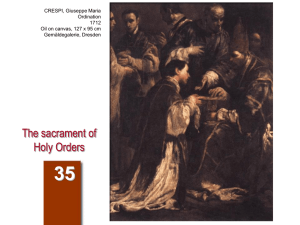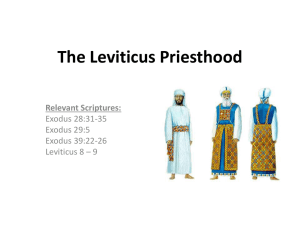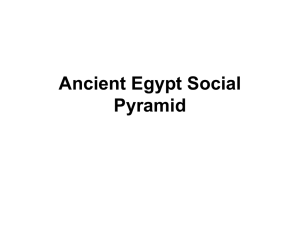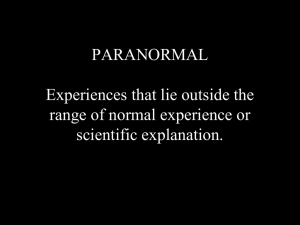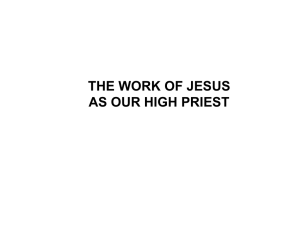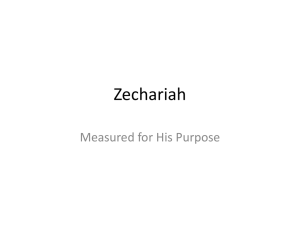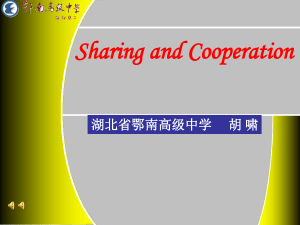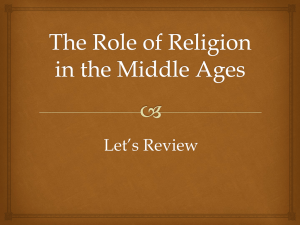Sanctuary-Study
advertisement
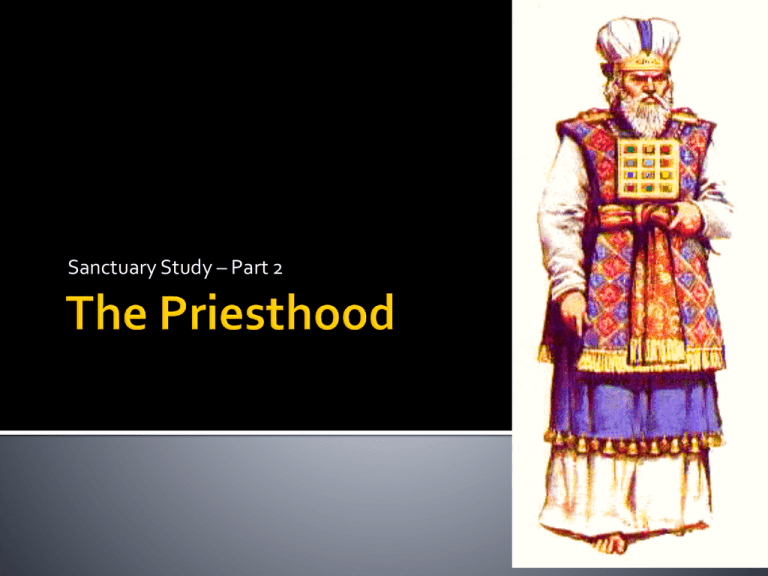
Sanctuary Study – Part 2 Foundation of the Sanctuary Service The Furniture of the Sanctuary Object Lessons in the Sanctuary Objects A latter-day counterfeit sanctuary service Orders & History of the Priesthood Function of the Priest The Levitical Priesthood Legitimacy Roles Support of Garments Christ our High Priest Two legitimate human orders of priesthood seen in the Bible 1. Melchizedek: Gen 14 v 18-20 2. Levitical: Num. 3 v 6,9,12,13 Melchizedek priesthood 1. Preceded & superior to the Levitical 2. Christ’s priesthood is said to be “after the order of Melchizedek” (Heb. 5 v 6) 3. We can therefore be said to be living under the Melchizedek order Fathers were the original priests of the household, an office that passed to the eldest son, with other benefits associated with the birthright Sin could disqualify an eldest son from receiving the birthright: Gen 35:22; 1 Chron 5:1,2 Reuben lost 1. The double portion to Joseph: 1 Chron 5:1 (Material birthright) 2. The honour of being the progenitor of the Messiah to Judah (1 Chron 5:2) 3. The spiritual birthright to Levi (Num 3:6,9) Levi gained the spiritual birthright because of faithfulness to God at a time of crisis i.e. major apostasy: Exod 32:25-29; Deut 33:8 Mediation Prime function of the priesthood God only accessible to the sinner through the mediation of the priesthood Reconciliation Sin separates us from God (Isa 59:2); but through the ministry of blood we are brought near (Lev 4; 2 Chron. 29:24) Sanctification Atonement service required not just forgiveness, but holiness i.e. a putting away/removal of all known sin Levites chosen in place of the firstborn males on account of their faithfulness Special consecration service undertaken: Num 8:9-14 All priests were Levites but not all Levites were priests Priests had to be descendents of Aaron or risk expulsion (Ex 28, 29; Lev 8-10, Num 3:10; Ezra 2:26). Levites Served under the direction of the priests Wilderness: Carried the tabernacle & its furniture but not permitted even to look upon it (Num 4:20) After temple building: Prepared showbread, led the singing, collected the tithe, did other work (1 Chron 23:24-32) centred around the court Not allowed to officiate at altar of burnt offering, burn incense or do any of priest’s work within the veil Served from 25 to 50 yo, then assumed “lighter duties” (Num 8:23-26) Priests Performed work related to sacrifices in the court & 1st apartment of the sanctuary, but not the altar of incense Moral guardians, custodians of the temple & responsible for entire outward worship of the nation Other responsibilities: ▪ Medical diagnosis & quarantine of disease (Deut 24:8,9; Lev 13,14) ▪ Jurisdiction in civil matters such as unfaithfulness (Num 5) ▪ Custodians of the law (Deut 17:8-13) Priests Subject to strict rules ▪ Physical deformity limited what a priest was allowed to do (Lev 21:21-23) ▪ Marriage: Could not marry a woman whose husband had put her away or divorced her, a prostitute or a violated maid (verses 7, 8) but could marry a virgin or widow ▪ Had to avoid ceremonial or physical defilement: not to touch dead bodies except a very near relative, avoid anything that could defile, The High Priest Occupied the most exalted place in Israel & meant to more nearly represent Christ than any other priest Could undertake all the functions of the priests; but solely responsible for daily offering incense morning and night on the golden altar in the holy place before the veil (Exod 30:7,8) 10th day of 7th month: Entered the most holy place to make atonement, bearing the names of the 12 tribes The High Priest Work of the other priests & Levites could be seen as being done for the high priest as helpers, simply because he could not do all the work himself i.e. It is impossible for one man to perform all the work of Christ, although the intention was for the high priest to represent that work Subject to stricter rules than priests e.g. could only marry a virgin (Lev 21:13,14) & not allowed to touch dead body even of close relative (v 1,2,11) Tithe: Numbers 18:20-24 Abraham returned tithes to Melchizedek (Gen 14:17- 20) & Jacob promised to pay tithe of all, even if he received only food and clothes (Gen 28:20-22) Parts of offerings & spoils (Deut 18:1,2; Num 18:8-11; 31:25-54; Lev 7:8); unredeemed land (Lev 27:20,21); “fines” (Lev 5:16; Num 5:8) Given 48 cities scattered among the tribes, from which they taught the people and were supported (Deut 33:8-11; Num 18:20; 35:1-8) Ordinary Priests: Garments of white linen Outer robe woven of one piece, extending nearly to feet “belt” or girdle embroidered in blue, purple & scarlet Mitre or turban Breeches (inside garments) Made for “glory & for beauty” Ex 28:40-42 High Priest: Ex 28 Same garments as ordinary priests underneath On top: robe of blue woven in one piece ▪ Beautifully ornamented around the skirt with golden bells & pomegranates of blue, purple and gold On top of this: Sleeveless garment known as the Ephod ▪ White linen embroidered in gold, blue, purple & scarlet ▪ Shorter than the others ▪ Held together at the waist by a belt (girdle) of the same design High Priest (Contd) Shoulders of ephod: ▪ Gold embroidery ▪ Two onyx stones (one on either shoulder) engraved with the names of the 12 tribes on Israel Breastplate ▪ Made of same material as ephod but more beautiful ▪ Square in design & attached to ephod ▪ Worn over the heart of the high priest High Priest (Contd) Breastplate (Contd) ▪ Twelve precious stones set in it, arranged 3 in a row ▪ Name of one tribe of Israel engraved on each stone ▪ Border of various stones around these 12 ▪ Two brilliant stones, called the Urim & Thummim, also set in the breastplate ▪ Used to ascertain God’s will Mitre with inscription: “Holiness to Jehovah” ▪ Fastened by blue lace 12 stones of breastplate (Ex 28:2-39): Sardius, topaz, emerald; turquoise, sapphire, diamond; jacinth, agate, amethyst; beryl, onyx, jasper Appear to be similar to the foundation stones of the New Jerusalem (Rev 21:19,20) C.f. Lucifer in Heaven (Ezek 28:13) Carnelian, chrysolite, emerald; topaz, onyx, jasper; lapis lazuli, turquoise, beryl Christ the antitypical High Priest (Heb 4:15) Earthly sanctuary an object lesson of the service in heaven Earthly priest required a blood sacrifice (Lev 4:27-29); Christ is Himself the Sacrifice (John 1:29,36) He pleads for us and we are accepted because of Him (Eph 1:6; John 10:17) Type: Blood shed in outer court & then priest entered sanctuary with the blood before Lord (Heb 9:12): Antitype: Christ gave His life on earth, & then entered the heavenly sanctuary with His blood as High Priest. He enters within the veil of the heavenly sanctuary (Heb 6:19,20) Heb 2:17-3:1 KJV Wherefore in all things it behoved him to be made like unto his brethren, that he might be a merciful and faithful high priest in things pertaining to God, to make reconciliation for the sins of the people. (18) For in that he himself hath suffered being tempted, he is able to succour them that are tempted. (3:1) Wherefore, holy brethren, partakers of the heavenly calling, consider the Apostle and High Priest of our profession, Christ Jesus; Stephen N. Haskell: “The Cross and Its Shadow”. Available from the Adventist Book Centre (www.adventistbookcenter.com) or the Stanborough Press M.L. Andreasen: The Sanctuary Service Available as a free pdf download at: http://www.remnant-prophecy.com/RemnantProphecy/D&R-CD11/StudyResources/The%20Sanctuary%20Service%20by%20 M.L%20Andreasen.pdf SDA Bible Commentary
